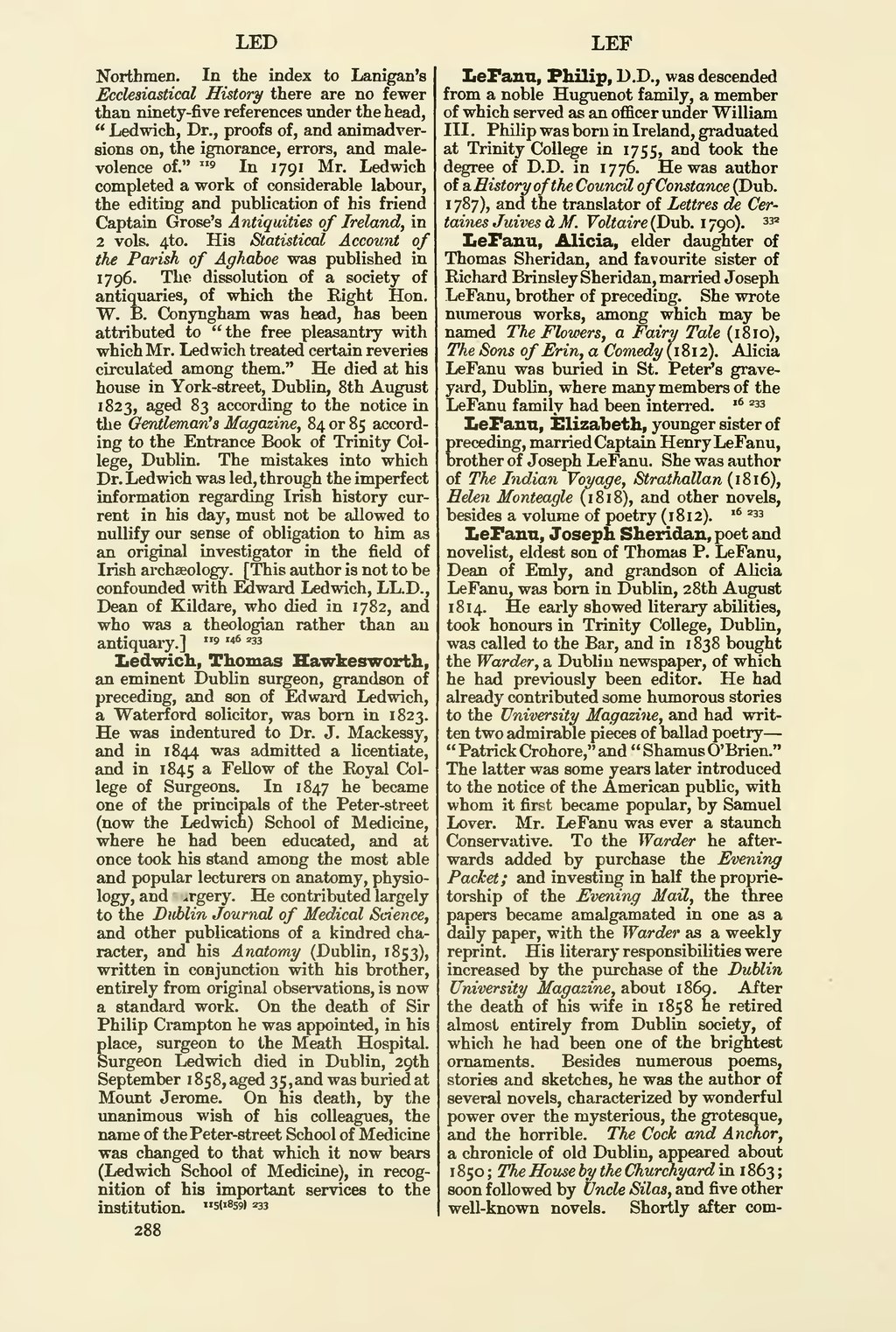Northmen. In the index to Lanigan's Ecclesiastical History there are no fewer than ninety-five references under the head, "Ledwich, Dr., proofs of, and animadversions on, the ignorance, errors, and malevolence of." 119 In 1791 Mr. Ledwich completed a work of considerable labour, the editing and publication of his friend Captain Grose's Antiquities of Ireland, in 2 vols. 4to. His Statistical Account of the Parish of Aghaboe was published in 1796. The dissolution of a society of antiquaries, of which the Right Hon. W. B. Conyngham was head, has been attributed to "the free pleasantry with which Mr. Ledwich treated certain reveries circulated among them." He died at his house in York-street, Dublin, 8th August 1823, aged 83 according to the notice in the Gentleman's Magazine, 84 or 85 according to the Entrance Book of Trinity College, Dublin. The mistakes into which Dr. Ledwich was led, through the imperfect information regarding Irish history current in his day, must not be allowed to nullify our sense of obligation to him as an original investigator in the field of Irish archaeology. [This author is not to be confounded with Edward Ledwich, LL.D., Dean of Kildare, who died in 1782, and who was a theologian rather than an antiquary.]119 146 233
Ledwich, Thomas Hawkesworth, an eminent Dublin surgeon, grandson of preceding, and son of Edward Ledwich, a Waterford solicitor, was born in 1823. He was indentured to Dr. J. Mackessy, and in 1844 was admitted a licentiate, and in 1845 a Fellow of the Royal College of Surgeons. In 1847 he became one of the principals of the Peter-street (now the Ledwich) School of Medicine, where he had been educated, and at once took his stand among the most able and popular lecturers on anatomy, physiology, and surgery. He contributed largely to the Dublin Journal of Medical Science, and other publications of a kindred character, and his Anatomy (Dublin, 1853), written in conjunction with his brother, entirely from original observations, is now a standard work. On the death of Sir Philip Crampton he was appointed, in his place, surgeon to the Meath Hospital. Surgeon Ledwich died in Dublin, 29th September 1858, aged 35, and was buried at Mount Jerome. On his death, by the unanimous wish of his colleagues, the name of the Peter-street School of Medicine was changed to that which it now bears (Ledwich School of Medicine), in recognition of his important services to the
institution. 115(1859) 233
LeFanu, Philip, D.D., was descended from a noble Huguenot family, a member of which served as an officer under William III. Philip was born in Ireland, graduated at Trinity College in 1755, and took the degree of D.D. in 1776. He was author of a History of the Council of Constance (Dub. 1787), and the translator of Lettres de Certaines Juives à M. Voltaire (Dub. 1790). 332
LeFanu, Alicia, elder daughter of Thomas Sheridan, and favourite sister of Richard Brinsley Sheridan, married Joseph LeFanu, brother of preceding. She wrote numerous works, among which may be named The Flowers, a Fairy Tale (1810), The Sons of Erin, a Comedy (1812). Alicia LeFanu was buried in St. Peter's graveyard, Dublin, where many members of the LeFanu family had been interred.
LeFanu, Elizabeth, younger sister of preceding, married Captain Henry LeFanu, brother of Joseph LeFanu. She was author of The Indian Voyage, Strathallan (18 16), Helen Monteagle (1818), and other novels, besides a volume of poetry (181 2). 16 233
LeFanu, Joseph Sheridan, poet and novelist, eldest son of Thomas P. LeFanu, Dean of Emly, and grandson of Alicia LeFanu, was born in Dublin, 28th August 1814. He early showed literary abilities, took honours in Trinity College, Dublin, was called to the Bar, and in 1838 bought the Warder, a Dublin newspaper, of which he had previously been editor. He had already contributed some humorous stories to the University Magazine, and had written two admirable pieces of ballad poetry — "Patrick Crohore," and "Shamus O'Brien." The latter was some years later introduced to the notice of the American public, with whom it first became popular, by Samuel Lover. Mr. LeFanu was ever a staunch Conservative. To the Warder he afterwards added by purchase the Evening Packet; and investing in half the proprietorship of the Evening Mail, the three papers became amalgamated in one as a daily paper, with the Warder as a weekly reprint. His literary responsibilities were increased by the purchase of the Dublin University Magazine, about 1869. After the death of his wife in 1858 he retired almost entirely from Dublin society, of which he had been one of the brightest ornaments. Besides numerous poems, stories and sketches, he was the author of several novels, characterized by wonderful power over the mysterious, the grotesque, and the horrible. The Cock and Anchor, a chronicle of old Dublin, appeared about 1850; The House by the Churchyard in 1863; soon followed by Uncle Silas, and five other well-known novels. Shortly after com-

